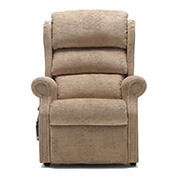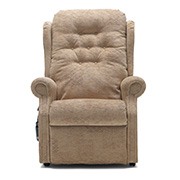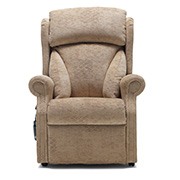A Guide to Rise and Recline Armchairs
When it comes to shopping for rise and recline armchairs, there are various factors to consider. These typically include: how exactly you’d like the chair to move, what kind of backrest style you’ll want, material choice, and whether you’ll need any pressure care.
It’s an awful lot to take in, so we’ve broken it down into chunks.
Motor Action
Most rise and recline armchairs offer three different kinds of motor action:
1. Single motor (with tilt-in-space option)
2. Dual motor (with tilt-in-space option)
3. Triple motor
A single motor armchair means that the recline movement in the legrest and the recline movement in the backrest are linked. This means that as you raise the legrest, the back reclines slightly. For the majority of, this is a very comfortable position, however, if you have breathing difficulties or need to take your meals in the chair, it might not suit you.
If you would like to operate the legrest and backrest separately, then a dual motor is for you. A dual motor offers more control, so if you would like to recline your back and head, but would rather your feet stayed flat on the floor, you’d simply use the hand controls to move one part of the chair and not the other.
Tilt in space
Tilt-in-space holds the user in a fixed position when in recline with the angle of the hip and the back remaining constant. This avoids any sliding forward in the chair and redistributes weight over a larger surface area to reduce the likelihood of pressure ulcers.
In addition to the one motor tilt in space action above, a second motor allows the client to set the back angle independently at any point in the recline cycle.
Where a higher weight limit is needed, a triple motor riser recliner offers allows for extra lifting capacity on the footboard – but you’ve still got a full range of seating positions, including near-horizontal recline.
Backrest Style
The following backrest styles are available across our riser recliner range, but are common styles you might stumble across elsewhere.
 |
Waterfall back Exceptional comfort and positioning when seated; the three fibre-filled pillows can be adjusted to suit individual needs, while the generous wings support the cushioning and in turn the seated individual. |
 |
Button back This style of buttoned backrest provides more structured support and positioning than the fibre-filled cushion styles, for those users that prefer a more definitive seated position. |
 |
Lateral/Lumbar support back A super comfortable two-pillow back that can be adapted to suit different postures and provides excellent lumbar support. |
With all our chairs, you can choose to add an additional neck rest. These simply hang from the back of the chair and help keep your head more upright.
Material
With most chairs, you’ll have a wide selection of materials to choose from. As well as the obvious things, like whether you want fabric or leather, and your preferred pattern or colour, you’ll be able to specify whether you want your material to be standard, breathable or washable.
1. Standard material, which is usually available in a wide range of colours and patterns. Some rise and recline chair manufacturers also produce non-specialist seating, such as sofas and static chairs. This can be beneficial if you want all your furniture to match, as they can use the same material.
2. Breathable – this allows the air to fully circulate, preventing a build-up of excess body heat. This might be preferable if you’ll be sitting in the chair for long periods at a time.
3. Waterproof – for easy cleaning of leaks or spills.
Pressure Relief
To avoid a painful posterior, some people opt for specialist pressure relief with their chairs. You can achieve this in two different ways.
1. In-built
Your chair will come with a pressure-relief cushion in the seat. This could either be in the form of memory foam or a gel, which evenly distributes the pressure. The main benefit of this is that it’s very discreet. The pressure relieving cushion is stitched into the seat itself and covered with the same fabric – you wouldn’t know it was there. You’ve even got the option of extending the pressure relief to the footboard for those at particularly high risk.
2. Cut-out
Placing a pressure-relieving cushion on top of an armchair’s standard seat cushion would result in a very high and uncomfortable position. So, if you have a specific pressure relief cushion that you would like to use, for example an alternating air cushion (which is controlled by an electronic pump), you can choose to have a cut-out area of your chair seat to accommodate it. The benefit of this is that you can use your own specialist cushion and take it with you wherever you go. However, the overall aesthetic might not be as desirable.
There’s also a range of other safety and transfer options to choose from, including removable arms and anti-entrapment, as well as handy accessories like an in-built USB port.
All of our riser recliner armchairs are manufactured in the UK and are available to view in our Ipswich showroom. If you’d like to chat to one of our showroom team, they’ll be happy to take your call. You can speak to Elizabeth or Linda on 01473 741 144.
Reuben Bush
Reuben joined the Felgains team in August 2019, bringing with him passion and experience in marketing and design – from a rather different sector. His focus is now on improving each and every touchpoint of our customer experience and building a vast following of raving fans! He loves road cycling, and also happens to have rather a weakness for food – he’s a bona fide chocoholic!



